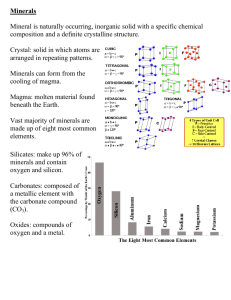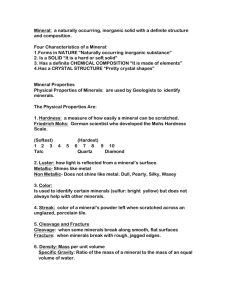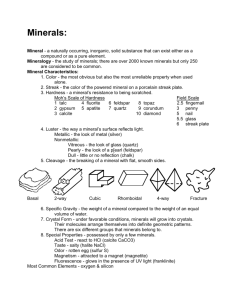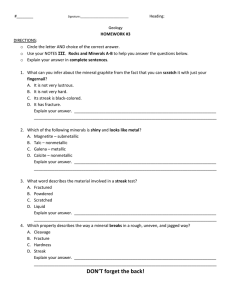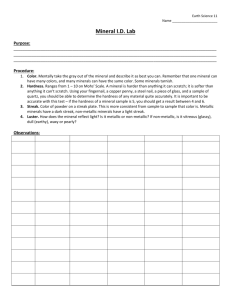Mineralpacket
advertisement
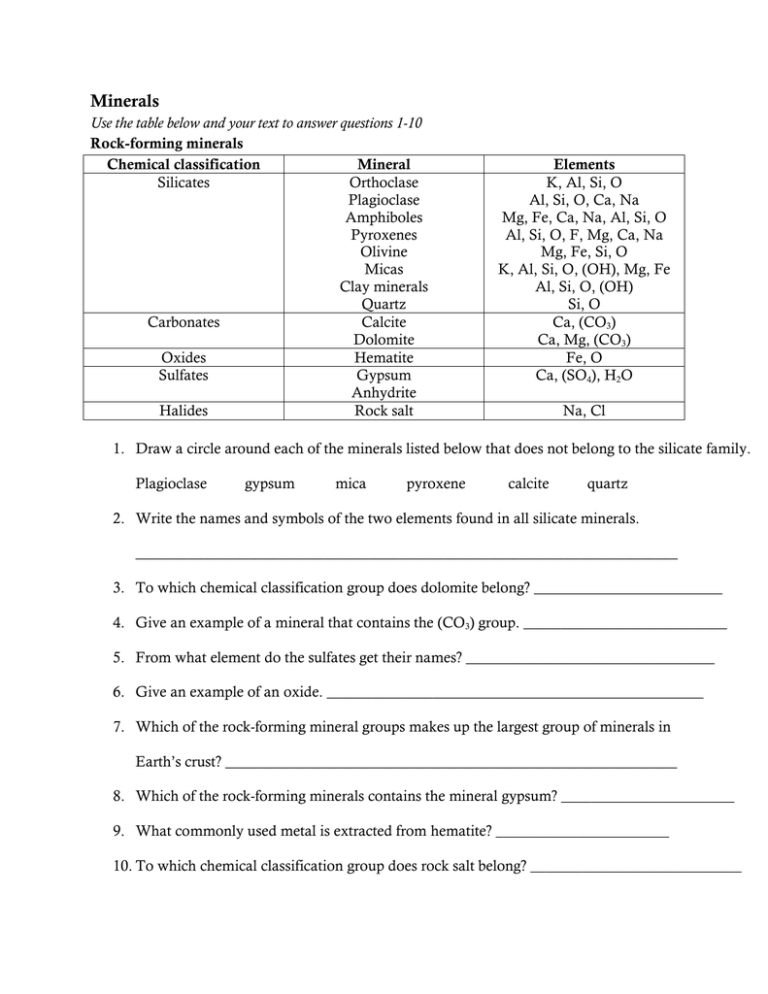
Minerals Use the table below and your text to answer questions 1-10 Rock-forming minerals Chemical classification Mineral Silicates Orthoclase Plagioclase Amphiboles Pyroxenes Olivine Micas Clay minerals Quartz Carbonates Calcite Dolomite Oxides Hematite Sulfates Gypsum Anhydrite Halides Rock salt Elements K, Al, Si, O Al, Si, O, Ca, Na Mg, Fe, Ca, Na, Al, Si, O Al, Si, O, F, Mg, Ca, Na Mg, Fe, Si, O K, Al, Si, O, (OH), Mg, Fe Al, Si, O, (OH) Si, O Ca, (CO3) Ca, Mg, (CO3) Fe, O Ca, (SO4), H2O Na, Cl 1. Draw a circle around each of the minerals listed below that does not belong to the silicate family. Plagioclase gypsum mica pyroxene calcite quartz 2. Write the names and symbols of the two elements found in all silicate minerals. ________________________________________________________________________ 3. To which chemical classification group does dolomite belong? _________________________ 4. Give an example of a mineral that contains the (CO3) group. ___________________________ 5. From what element do the sulfates get their names? _________________________________ 6. Give an example of an oxide. __________________________________________________ 7. Which of the rock-forming mineral groups makes up the largest group of minerals in Earth’s crust? ____________________________________________________________ 8. Which of the rock-forming minerals contains the mineral gypsum? _______________________ 9. What commonly used metal is extracted from hematite? _______________________ 10. To which chemical classification group does rock salt belong? ____________________________ Mineral Identification In the blank at the left, put a check mark next to each statement that agrees with the textbook. _________ 1. The physical properties of a mineral can be seen or measured in some way. _________ 2. The physical properties of a mineral make it possible to identify the mineral. _________ 3. Any mineral can be identified by a careful check of one physical characteristic. _________ 4. Hardness is a measure of how easily a mineral can be located. _________ 5. Friedrich Mohs developed a scale which lists minerals according to their hardness. _________ 6. Quartz will scratch a piece of copper, so quartz is harder than copper. _________ 7. The luster of a mineral is described as metallic or nonmetallic. _________ 8. The luster of chrome would be described as nonmetallic. _________ 9. Color alone is not usually enough to identify a mineral. _________ 10. When some minerals are rubbed across unglazed porcelain, they leave a streak of powdered material. _________ 11. Graphite is a mineral that does not leave a clear streak. _________ 12. Topaz is a mineral that does not leave a clear streak. _________ 13. Most minerals cannot be broken. _________ 14. Mica shows clear cleavage. _________ 15. Quartz is a mineral with a fracture. Match the mineral names in Column I with the descriptions in column II. Write the letter of the correct description in the blank on the left. Column I ________ 16. Magnetite ________ 17. Pyrite ________ 18. Talc ________ 19. Calcite ________ 20. Gold Column II a. Light yellow color; metallic luster; hardness of 6; greenish-black streak b. Light color; fingernail will scratch it out of the rock; leaves thick, powdery streak. c. Black color; black streak; dull metallic luster; attracts small iron objects. d. Yellow color; scratched by copper penny; often found in flakes. e. White color; irregular shape; dull luster; hardness of 3; fizzes in hydrochloric acid. Table 1: Mohs’ Scale of Mineral Hardness Mineral Hardness Field Test 1 Easily scratched by a fingernail 2 Can be scratched by a fingernail 3 Barely scratched by a copper penny 4 Easily scratched by a steel knife blade 5 Can be scratched by a steel knife blade 6 Easily scratches glass 7 Easily scratches glass and steel 8 Scratches quartz 9 No simple test 10 No simple test Use the information given below to identify the mineral that belongs in the first column in the table. Write the correct name next to the hardness number in column 2. 1. The hardest mineral on Mohs’ scale is diamond. The softest is talc. 2. Corundum can scratch all of the minerals on Mohs’ scale, except diamond. 3. Of the minerals listed on Mohs’ scale, gypsum can scratch only talc. 4. Quartz is slightly harder than feldspar. Both minerals can scratch glass, but only quartz can scratch steel. 5. Quartz and calcite can look similar. In a field test, a copper penny could be used to scratch calcite. However, the same penny could not scratch quartz. 6. Apatite can scratch fluorite, calcite, talc, and gypsum. Fluorite cannot scratch apatite, but it can scratch talc, gypsum, and calcite. 7. Topaz can scratch all minerals on Mohs’ scale, except for corundum and diamond.
